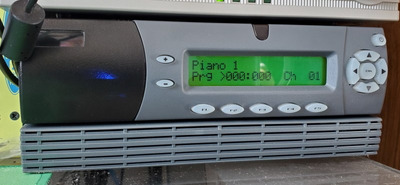First post, by floomsy
Hello VOGONS, this is my first ever post here.
Last year I started working on a device to fill a specific niche of mine -- that is, I needed a way to use sounds from out of a SB Live to sequence from my Windows 10 machine. The reason for this is there were some old soundfonts from Hammersound (Gort's Synth and some others) that were designed using loads of resonant filters, and those filters don't get treated the same throughout the different generations of Sound Blaster soundfont devices, or soft-synths for that matter.
I'm using Python 3.4 with the rtmidi library to feed incoming MIDI signals from the gameport into the SB Live synth to create audio. There's also an LCD text display and keypad I've gotten to work, complete with an animated bar activity display. However this is my first time creating any type of front-end interface, so while the backend is reasonably neat, the interface is VERY messy behind the scenes. And, yes, it's a regular Windows PC underneath -- I'm using an NVIDIA ION board to run the show. Overkill, I know, but that was what I had to work with.
I've posted up some demonstrations on my website including a track I've made that uses the sounds which come out of it.
I settled on the name Liverator from "Live Generator". The device is rather basic looking, that's a mini-box M300-LCD enclosure. I haven't got the skills to design my own at the moment. I spent somewhere around $160 in parts to build this device. Some other pieces were spares, like the motherboard.
It's been dormant for some time, but I'm now planning to add a second MIDI connector (to use all 32 MIDI channels the card has) and Toslink optical out, which I will build as a custom board to substitute the Live Drive.
I hope to some of you out there this has some degree of interest, thanks for reading.
